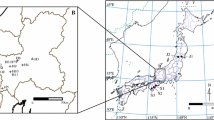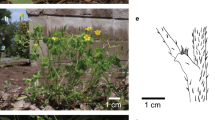Abstract
Relationships amongCalamagrostis longiseta var.longiseta, C.l. var.longe-aristata andC. fauriei, which are principally at the 2n=28 chromosome level, were studied mainly on the basis of population samples. The populations comprised (1) “pure” populations of each ofC.l. longiseta, C.l. longe-aristata andC. fauriei and (2) populations showing a gradation fromC.l. longiseta toC. fauriei via the intermediateC.l. longearistata and fromC.l. longiseta toC.l. longe-aristata. Hybridization betweenC.l. longiseta andC. fauriei was estimated to be ultimately related to the geneses of the population structures detected, and it was concluded thatC.l. longe-aristata must be of hybrid origin betweenC.l. longiseta andC. fauriei. Populations showing a gradation fromC.l. longiseta toC.l. longe-aristata were regarded to have been brought about by the extinction ofC. fauriei from the hybridizing population coupled with the change of environments and also by the secondary contact betweenC.l. longiseta and plants ofC.l. longe-aristata migrating from the area that produced it. No significant reduction of pollen fertility and seed productivity was found inC.l. longe-aristata. Based on the results of population analyses, the delimitation of the taxa concerned was made clearer. The examination of herbarium specimens showed that the range ofC.l. longe-aristata considerably exceeds the overlapping area of the present ranges ofC.l. longiseta andC. fauriei. The three taxa were deviated ecologically, and “pure” populations ofC.l. longe-aristata were found on several damp subalpine fields in central and northern Honshu that seemed to represent the most suitable niche for this taxon. It was estimated thatC.l. longe-aristata would evolve into a new good species if the future organism-environment interactions are favorable for it.
Similar content being viewed by others
References
Alston, R.E. andB.L. Turner. 1962. New techniques in analysis of complex natural hydridization. Proc. Nat. Acad. Sci.48: 130–137.
Benson, L., E.A. Phillips, P.A. Wilder et al. 1967. Evolutionary sorting of characters in a hybrid swarm. I: Direction of slope. Amer. J. Bot.54: 1017–1026.
Bradshaw, A.D. 1972. Some of the evolutionary consequences of being a plant. Evol. Biol.5: 25–43.
Burger, W.C. 1975. The species concept inQuercus. Taxon24: 45–50.
Carter, L.C. andB.G. Brehm. 1969. Chemical and morphological analysis of introgressive hybridization betweenIris tenax andI. chrysophylla. Brittonia21: 44–54.
Crawford, D.J. 1972. The morphology and flavonoid chemistry of synthetic infraspecific hybrids inCoreopsis mutica (Compositae). Taxon21: 27–38.
Cronquist, A. 1968. The Evolution and Classification of Flowering Plants. Thomas Nelson, London.
Gajewski, W. 1957. A cytogenetic study on the genusGeum. Monographiae Bot.4: 1–416.
Gillet, G.W. 1966. Hybridization and its taxonomic implications in theScaevola gaudichaudiana complex of the Hawaiian Islands. Evolution20: 506–516.
Hickey, D.A. andT. McNeilly. 1975. Competition between metal tolerant and normal plant populations; A field experiment on normal soil. Evolution29: 458–464.
Hitchcock, A.S. and A. Chase. 1951. Manual of the grasses of the United States. U.S. Dept. Agric. Miscel. Publ. No. 200.
Honda, M. 1936.Ancistrochloa, a new genus of Poaceae. J. Jap. Bot.12: 18–19.
Levin, D.A.. 1967. Hybridization between annual species ofPhlox: Population structure. Amer. J. Bot.54: 1122–1130.
— 1971. The origin of reproductive isolating mechanisms in flowering plants. Taxon20: 91–113.
Lewis, H. andC. Epling. 1959.Delphinium gypsophilum, a diploid species of hybrid origin. Evolution13: 511–525.
McHale, J. andR.E. Alston. 1964. Utilization of chemical patterns in the analysis of hybridization betweenBaptisia leucantha andB. sphaerocarpa. Evolution18: 304–311.
Nobs, M.A. 1963. Experimental studies on species relationships inCeanothus. Carnegie Inst. Wash. Publ. No. 623.
Nygren, A. 1954. Investigations on North AmericanCalamagrostis. Hereditas40: 377–397.
— 1962. Artificial and natural hybridization in EuropeanCalamagrostis., Symb. Bot. Upsal.XVII/3: 1–105.
Ohwi, J. 1936. A revision of the Japanese species ofCalamagrostis. Acta Phytotax. Geobot.5: 225–242.
Powell, A.M. 1970. Natural intersectional hybridization inPerityle (Compositae). Brittonia22: 3–10.
Simpson, G.G. 1961. Principles of Animal Taxonomy. Columbia Univ. Press, New York.
Smith, H.H. andK. Daly. 1959. Discrete populations derived by interspecific hybridization and selection inNicotiana. Evolution13: 476–487.
Stebbins, G.L. 1969. The significance of hybridization for plant taxonomy and evolution. Taxon18: 26–35.
— 1974. Flowering Plants: Evolution above the Species Level. Harvard Univ. Press, Cambridge.
— andK. Daly. 1961. Changes in the variation pattern of a hybrid population ofHelianthus over an eight-year period. Evolution15: 60–71.
Stutz, H.C. andL.K. Thomas. 1964. Hybridization and introgression inCowania andPurshia. Evolution18: 183–195.
Tateoka, T. 1970. Recognition ofCalamagrostis × microtis (Gramineae). Bull. Natn. Sci. Mus.13: 275–290.
— 1972. An analysis of theCalamagrostis longiseta complex in Mt. Echigo-Komagatake. Bull. Natn. Sci. Mus.15: 385–394.
— 1976. Chromosome numbers of the genusCalamagrostis in Japan. Bot. Mag. Tokyo89: 99–114.
— 1977. Natural hybridization in JapaneseCalamagrostis. I. Several interspecific combinations in central Honshu. Bot. Mag. Tokyo90: 103–128.
Valentine, J.W. 1967. The influence of climatic fluctuations on species diversity within the tethyan provincial system.In: C.G. Adams and D.V. Ager, ed. Aspects of Tethyan Biogeography (Systematics Assoc. Publ. No. 7) p. 153–166.
Whittaker, R.H. andP.P. Feeny. 1971. Allelochemics: Chemical interactions between species. Science171: 757–770.
Author information
Authors and Affiliations
Rights and permissions
About this article
Cite this article
Tateoka, T. Natural hybridization in JapaneseCalamagrostis . Bot Mag Tokyo 91, 141–171 (1978). https://doi.org/10.1007/BF02489352
Received:
Issue Date:
DOI: https://doi.org/10.1007/BF02489352




